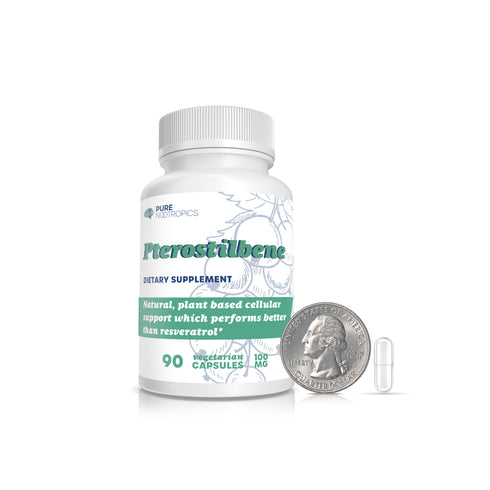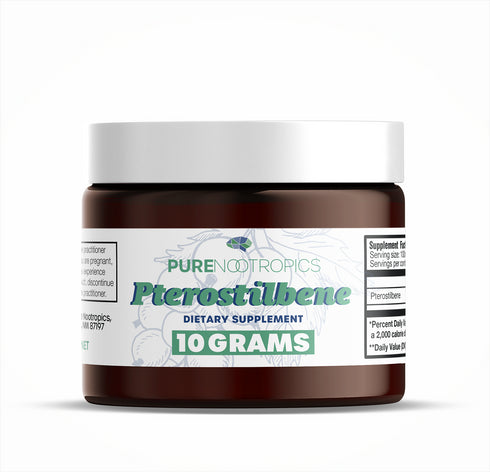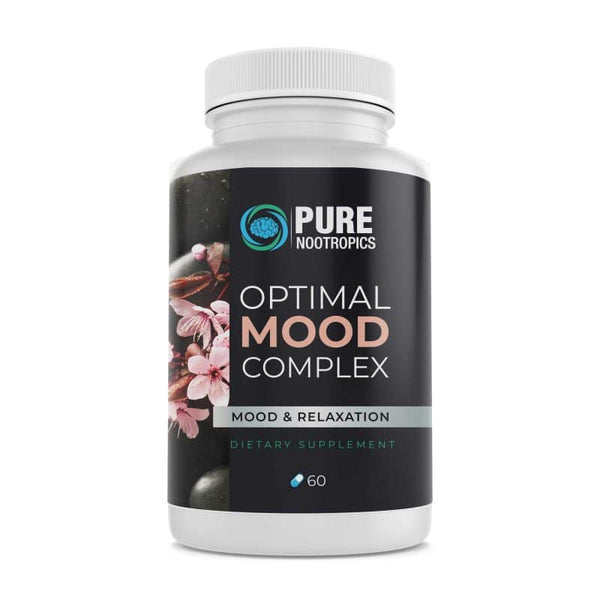Pterostilbene is a phenol similar to resveratrol and is found in blueberries and grapes.
Pterostilbene Benefits
- Natural, plant based cellular support which performs better than resveratrol* (ref)*
- Promotes cellular health while aging when paired with NAD+ Precursors (ref)*(ref)*
Pterostilbene Mode of Action
Pterostilbene is a polyphenol contained in plants, fruits, and nuts, with the highest concentration in blueberries and grapes (1, 2). It is very similar to resveratrol and differs only through two methoxy groups on the molecule instead of the two hydroxy groups found on the resveratrol molecule. Both resveratrol and Pterostilbene are phytoalexins, compounds that plants produce which function as self-defense against insects and parasites (1).
Pterostilbene is more potent than resveratrol and has a higher bioavailability (1).
Pterostilbene, when combined with NAD (nicotinamide riboside) intermediate products promotes cellular health while aging due to its ability to raise NAD levels (nicotinamide adenine dinucleotide) (3). NAD biosynthesis in mammals is a pathway involved in cells throughout the body and is believed to regulate the process of aging. Nicotinamide is converted into NMN which is then converted into NAD. Intermediate enzymes, like nicotinamide riboside (NR), increase the available NAD and contributes to overall cellular lifespan and cellular health in the body (4).
Pterostilbene Dosage
Pure Nootropics’ Pterostilbene Capsules provide 100 mg per 1 capsule. The pure powder option contains 10 grams total and a scale should be used for measuring accuracy. Suggested use for an adult is 100mg or 1 capsule by mouth once daily, or as directed by your healthcare practitioner.
If you are taking any medications, always consult with you Healthcare Practitioner before beginning any new supplement.
For further information, please see our References Tab above.
The references below are not meant to imply that any of our products treat, cure, or diagnose any disease or human condition. References to clinical studies and pre-clinical studies may use varying dosages and may not represent the dosages or subsequent results of products we sell; however, the references provided are pertinent to the subject supplement itself. References provided are intended for research and informational purposes only and do not represent the entire body of knowledge available on the subject(s) referenced; nor do they represent all possible outcomes associated with the subject(s) referenced including, but not limited to, adverse effects, precautions, or chemical interactions within the human body. The Content provided on this website is not intended to be a replacement for professional medical advice, treatment or diagnosis. Never ignore the advice of a medical professional or delay in attaining professional advice because of information or impressions you gather on this website. Choosing to rely on any information provided by the Content of this website is solely at your own risk. We encourage our audience to do their own research beyond the resources we have provided so your decision is as educated as possible.
• Natural, plant based cellular support which performs better than resveratrol* *
“Pterostilbene”. Examine.com, published Aug 5, 2014. Last updated Jun 14, 2018. doi:10.12688/f1000research.12120.1.
• Promotes cellular health while aging when paired with NAD+ precursors*
Dellinger, Ryan W., et al. “Repeat Dose NRPT (Nicotinamide Riboside and Pterostilbene) Increases NAD Levels in Humans Safely and Sustainably: a Randomized, Double-Blind, Placebo-Controlled Study.” NPJ Aging and Mechanisms of Disease, vol. 3, no. 17, 2017, www.nature.com/articles/s41514-017-0016-9.
Johnson, Sean, and Shin-Ichiro Imai. “NAD + biosynthesis, aging, and disease.” F1000Research vol. 7 132. 1 Feb. 2018, doi:10.12688/f1000research.12120.1.
1. “Pterostilbene”. Examine.com, published Aug 5, 2014. Last updated Jun 14, 2018. https://examine.com/supplements/pterostilbene/.
2. Brenner, Charles, and Amy C. Boileau. “Pterostilbene Raises Low Density Lipoprotein Cholesterol in People.” Clinical Nutrition, vol. 38, no. 1, Feb. 2019, pp. 480–1., doi:https://doi.org/10.1016/j.clnu.2018.10.007.
3. Dellinger, Ryan W., et al. “Repeat Dose NRPT (Nicotinamide Riboside and Pterostilbene) Increases NAD Levels in Humans Safely and Sustainably: a Randomized, Double-Blind, Placebo-Controlled Study.” NPJ Aging and Mechanisms of Disease, vol. 3, no. 17, 2017, www.nature.com/articles/s41514-017-0016-9.
4. Johnson, Sean, and Shin-Ichiro Imai. “NAD + biosynthesis, aging, and disease.” F1000Research vol. 7 132. 1 Feb. 2018, doi:10.12688/f1000research.12120.1.
5. Daniel M. Riche, Corey L. McEwen, Krista D. Riche, et al., “Analysis of Safety from a Human Clinical Trial with Pterostilbene,” Journal of Toxicology, vol. 2013, Article ID 463595, 5 pages, 2013. https://doi.org/10.1155/2013/463595.
6. Riche, DM, et al. “Pterostilbene on Metabolic Parameters: a Randomized, Double-Blind, and Placebo-Controlled Trial.” Evid Based Complement Alternat Med., vol. 2014, no. 459165, 2014, doi:10.1155/2014/459165.





























